A portable oxygen concentrator is a medical assistive device that enables people with respiratory issues to maintain an active lifestyle.
The portable oxygen concentrator negates the need for carrying heavy and dangerous oxygen tanks with you everywhere. Most provide both continuous flow and pulse mode, and can be used during the day and at night.
If you suffer from COPD, emphysema, chronic bronchitis, or any other respiratory condition, the portable oxygen concentrator will provide the oxygen you need without tethering you to the house or hospital.
Below are the best portable oxygen concentrators on the market, updated for 2023.
Rankings
1. Zen-O Portable Oxygen Concentrator
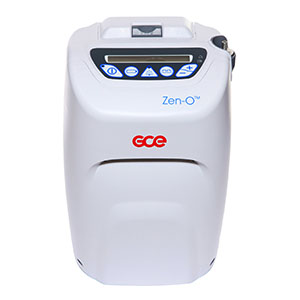
Zen-O has your outdoor life in mind. This portable oxygen concentrator enables you to get up off the couch and get back in the game. It is about as close as you will find to an ‘affordable’ oxygen concentrator.
What we like: The LCD readout is large and clear. The Zen-O is very easy to use. Its 2-liter per minute flow rate is enough for most people under most conditions. It is also well-built, durable, and easy to clean.
Flaws: Slung over the shoulder it weighs more than 10 pounds. Not designed for those with severe respiratory conditions.
2. Respironics SimplyGo
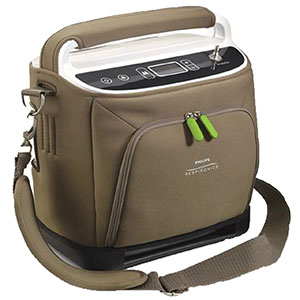
The SimplyGo from Respironics is powerful, versatile, and easy to use. It features one of the best, purpose-built carrying cases you will find and can accompany you wherever you go. This is a well-engineered, well-built device that will last for years.
What we like: We love how small and convenient the SimplyGo is. It is one of the few, true travel-ready oxygen concentrators. It can be used during the day or night and features both continuous flow and pulse mode.
Flaws: With wheels that protrude from the sides, the cart can sometimes get in the way while walking.
3. Inogen G4 Single Battery
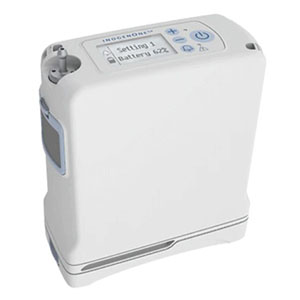
Inogen makes two variations of the G4. One uses a dual-battery system, and this uses a single battery. If you typically make quick jaunts to the market or just need something to help you get from house to house, here it is.
What we like: The single battery results in a lighter device that can be used by just about anyone. It makes a good choice for those who do not anticipate spending long hours outdoors or away from the house.
Flaws: Two hours is not that long. If you go out with the battery less than fully charged, you run the risk of the machine cutting out on you even sooner than that.
4. Phillips Respironics SimplyGo Mini
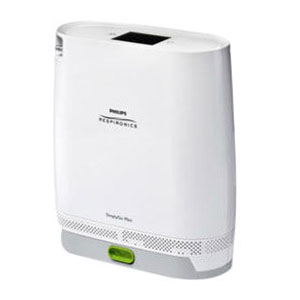
If the SimplyGo is not compact enough for your tastes, consider the SimplyGo Mini. It features the same outstanding build quality of the standard SimplyGo, but is one of the lightest and most compact portable oxygen concentrators around.
What we like: We appreciate the extended battery option that more than doubles battery life. The LCD touchscreen is clear and easy to navigate. And the incredibly compact size of the SimplyGo Mini makes it ideal for running errands.
Flaws: The LCD screen is relatively small and may be difficult for those with bad eyesight to read.
5. SeQual Eclipse 5 Portable Oxygen Concentrator
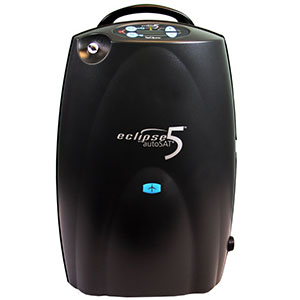
You cannot sling the SeQaul Eclipse 5 over your shoulder. But you can take it just about anywhere, and it will provide ample oxygen for virtually any respiratory condition. It is easy to use, dependable, and provides up to 3 liters per minute.
What we like: This is a very versatile device that will go with you on foot, in the car or on a plane. It can also be used in concert with a CPAP machine to provide relief from sleep apnea. It is easy to use with a simple, instinctive control panel.
Flaws: The battery life is not exactly robust. Also, it is too large and heavy even to consider carrying over the shoulder.
6. ResMed Mobi Portable Oxygen Concentrator
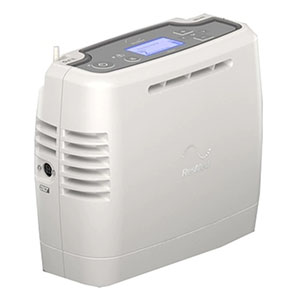
The ResMed Mobi comes with an outstanding 5-year warranty and weighs just a tad more than 5 1/2 pounds. It features four different pulse settings, as well as continuous flow, and above-average battery life.
What we like: We were pleasantly surprised by how compact this device is. As such, it is ideal for afternoons out, or as a travel companion. We also like that you can run it off the DC outlet in your car. And the carrying bag is well designed and comfortable.
Flaws: At 5 1/2 pounds, it is going to weigh on your shoulders after a while. It would have been nice if it came with a cart.
7. Hanyf Household Portable Oxygen Respirator
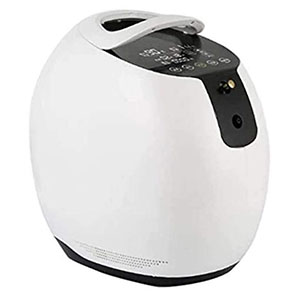
The name says it all with the Hanyf Household Portable Oxygen Concentrator. This is a portable device that is oriented toward home use. And yet, it will quickly move from room to room. Or even hose to house.
What we like: The device provides up to six liters per minute of oxygen. That is among the best you will find. It can be used day or night. And it is among the quieter oxygen concentrators on the market.
Flaws: It is only portable in the sense that you can easily move it from house to house, or house to hotel. Also, the control panel seems unnecessarily cluttered.
8. O2 Concepts Oxlife Independence
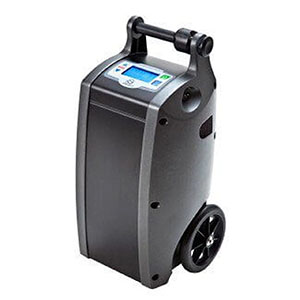
Because it is powerful and versatile, the O2 Concepts Oxlife Independence is larger than most shoulder units. But it is ideal for those with more acute respiratory conditions who want to retain their active lifestyle.
What we like: We like the power and dependability of the Oxlife. We appreciate it can be used in the house, in the car, or in the park. We appreciate that it offers both continuous flow and pulse mode. And that there are six pulse settings.
Flaws: At 16 3/4 pounds the Independence is the heaviest concentrator on our list. Depending on the condition of the user, it may be too much.
9. Philips Respironics Simplygo Mini
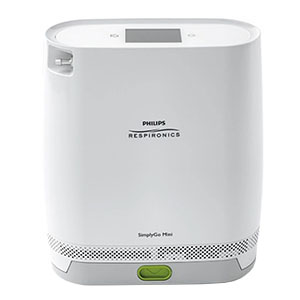
The last of our portable oxygen concentrators is this one from Philips Respironics. The Simplygo Mini is, as the name implies, a more compact version of their outstanding Simplygo that we profiled above. It offers a maximum flow of five liters and can easily be carried anywhere.
What we like: We appreciate how easy the device is to operate. It’s just as well-built as its slightly larger cousin, and like the Simplygo, it is FAA approved for flying. Can be charged via US or International power sources.
Flaws: The over the shoulder configuration will not appeal to everyone.
10. Inogen One G3 Portable Oxygen Concentrator
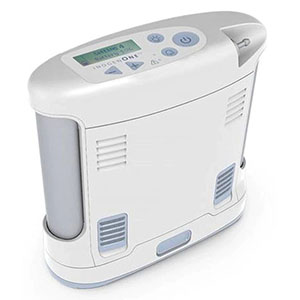
Inogen is an industry leader when it comes to portable oxygen concentrators. Their G3 is very well-built, versatile and powerful, and features a dual lithium-ion battery power pack. Ideal for those who venture out regularly.
What we like: We like that the G3 can be used indoors or out, during the day or at night. The fact that it comes with a DC adapter for your car is also a plus, as is the dual rechargeable lithium-ion battery power supply.
Flaws: The two batteries make this unit a bit heavier than some others.
Who Needs A Portable Oxygen Concentrator?
Anyone suffering from emphysema, COPD, pulmonary fibrosis, chronic bronchitis, and other respiratory conditions will likely benefit from a portable oxygen concentrator. The portable oxygen concentrator can provide these individuals with the ability to resume their normal activities and re-engage with life. At the same time, the concentrator will alleviate symptoms such as shortness of breath, dizziness, rapid heartbeat, lightheadedness, headaches, and more.
How We Ranked
Several things need to be considered when determining the relative worth of a portable oxygen concentrator. First and foremost of, course, is whether it actually delivers an adequate flow of oxygen. Because portable oxygen concentrators are considered Class II medical devices, and are regulated by the FDA (1)(2), we can assume that all such devices sold in the US will fulfill that role.
The next thing we considered when ranking our choices was whether a particular device offered both continuous flow mode and pulse mode. In the past, most oxygen concentrators offered either one or the other. Today, however, the best portable oxygen concentrators provide both. And we gave preference to those that do, simply because those devices provide the user with more options. And more options are a good thing.
The next most important consideration was battery life. This is one area where oxygen concentrators have seemingly lagged behind the rest of the high-tech world. Even the best ones typically provide only a few hours of battery life when the concentrator is set to continuous use. Still, those that came in at the high end of the battery life range got higher marks.
Build quality and usability were also key determinants. These devices need to withstand years of bouncing on someone’s shoulder or being rolled along the pavement without falling apart. We also gave preference to those that are easy to use, with clear display screens.
Finally, we gave some consideration to the price. But not as much as we might with other types of technology, like flatscreen TVs. That’s because all portable oxygen concentrators are expensive. There is no getting around it. There are no tiny discount models like there are with TVs. These devices have to meet FDA standards, and doing so is going to cost money.
FAQs
Q: What is a portable oxygen concentrator?
A: A portable oxygen concentrator is a small medical device that provides people with reduced respiratory function with elevated levels of oxygen. This oxygen-rich air helps make up for the inability of their lungs to glean enough oxygen from the air they breathe. Portable oxygen concentrators do not use tanks of oxygen, and so are much more convenient than older methods of supplemental oxygen delivery.
Q: Is a portable oxygen concentrator safe?
A: When used in accordance with the directions, a portable oxygen concentrator should be perfectly safe. There are some common-sense precautions you will need to take, however. Those include not using the concentrator outside on extremely hot days (typically, above 90-95 degrees Fahrenheit), not using it near someone who is smoking, and not storing it in direct sunlight.
Q: Will private insurance pay for a portable oxygen concentrator?
A: Unfortunately, it is unlikely that your private health insurance will pay for a portable oxygen concentrator. That is because most insurance companies only reimburse for the bare minimum amount of supplemental oxygen a person requires. And this level of oxygen can typically be supplied by other, less expensive devices.
Q: Will Medicare pay for a portable oxygen concentrator?
A: Medicare reduced the amount they were willing to reimburse for many portable oxygen concentrators in 2013. That said, you still have a much better chance of having your concentrator covered by Medicare than you do private insurance (3). The odds get even better if you have a Medicare Advantage plan (4). The devil, as always, is in the details. So make sure you have all your ducks in a row before submitting your claim.
Q: Can a portable oxygen concentrator help fight the coronavirus?
A: The coronavirus tends to attack the respiratory system. This can lead to the development of Acute Respiratory Distress Syndrome, or ARDS (5), which is actually responsible for most covid-19 related. Hyperbaric oxygen therapy (6) is the preferred method for combating the worst effects of ARDS. But portable oxygen concentrators may be of some help for those with less dire symptoms. If you have been diagnosed with covid-19 ask your doctor about using a portable oxygen concentrator.
Q: How do I know which portable oxygen concentrator is right for me?
A: This is an important question, and we would strongly advise anyone to discuss the matter thoroughly with their doctor before purchasing such a device. Indeed, in most cases, you will need a doctor’s prescription to purchase a portable oxygen concentrator. Your doctor will also be able to provide precise settings that will enable you to obtain maximum benefits from your oxygen concentrator.
Q: How does a portable oxygen concentrator work?
A: The air we breathe is composed mostly of nitrogen and oxygen (7). With nitrogen making up nearly 80 percent of the air we breathe. A portable oxygen concentrator works by pulling in air from the surrounding environment. Once inside, that air is subjected to a filter that removes most of the nitrogen. The air that emerges from the concentrator is oxygen-rich. It is then fed to the user by way of a small tube attached to their nose.
Q: Is there a difference between pulse dose and continuous flow?
A: There is. Continuous flow means that oxygen is fed to the user at a steady, unchanging rate. Pulse dose means that oxygen is fed to the user only when they inhale. It must be noted, however, that most of today’s portable oxygen concentrators offer both continuous flow and pulse dose. So you are not forced to choose between one and the other.
Q: Can I use both kinds of oxygen concentrators at night?
A: In theory you might be able to. But in practice, you do not need to. Historically, most doctors recommended their patients use continuous flow mode while sleeping. But recent studies suggest that pulse mode may be just as effective (8). Since most of today’s portable oxygen concentrators offer both continuous and pulse mode, you do not have to worry. You will be able to use it, no matter which mode your doctor recommends.
Q: Are portable oxygen concentrators high maintenance machines?
A: Not really. While portable oxygen concentrators are not maintenance-free, it would be a mistake to call them ‘high maintenance’. In most cases, maintenance will entail little more than cleaning the device and swapping out an old filter for a new one occasionally (9). Some companies specialize in maintaining these devices. Speak to the seller or manufacturer about this before buying the device.
Q: Can you take a portable oxygen concentrator on a plane?
A: The FAA allows for the use of portable oxygen concentrators on commercial aircraft (10). That said, not all airlines will allow passengers to use these devices on their planes. Also, you may have to jump through a few hoops to get your portable oxygen concentrator past TSA (11). Typically, the more experienced the TSA agent, the less hassle.
Q: Can you use a portable oxygen concentrator in a car?
A: You can. Portable oxygen concentrators are just that, portable. So you can use yours in your car, RV, or on the bus. If the battery runs low while in the car, you can obtain power from the car itself. Most modern cars have adapted the former cigarette lighter on the dashboard to be an all-purpose electric power outlet (12). All you need is a DC adapter, and you can plug your oxygen concentrator into this outlet.
Q: Is there such a thing as oxygen overdose?
A: Yes, there is such a thing as getting too much oxygen. Symptoms of oxygen toxicity (13), as it is called, include respiratory distress and problems with your vision. It is extremely unlikely a portable oxygen concentrator would produce oxygen toxicity. Nonetheless, you should take care to work with your doctor to determine the precise oxygen levels you need before you start using the device.
Q: How long does a portable oxygen concentrator last?
A: The bad news is that portable oxygen concentrators are expensive. The good news is that they a very well-engineered and well-built. As a result, it is not unheard of for people to get 5-10 years from their unit. Besides build quality, other things that influence how long the device lasts include your usage settings, how frequently you use it, whether you use the concentrator in scorching weather, and whether the device is dropped or mishandled.
Q: Do you have to be careful when moving an oxygen concentrator?
A: Portable oxygen concentrators are rugged, durable devices that are built to withstand being bounced on your shoulder all day. So, you do not need to take any particular precautions when moving them, other than being careful not to drop them. Dropping the device could damage the battery and cause it to leak. That, in turn, would increase the risk of it causing a fire. Also, do not store or charge the battery in direct sunlight (14).
Q: Can a portable oxygen concentrator explode?
A: A lot of folks are concerned about this, and for good reason. Oxygen itself is not explosive (15), and it is not flammable. But it is an ‘oxidizer’. That means it will turn a small spark or fire into a big, intense fire very quickly. For this reason, you want to keep your oxygen concentrator away from open flames, space heaters, the fireplace, or people who are smoking. You should also make sure to store it in a cool place.
Q: Is a portable oxygen concentrator the same as a home oxygen concentrator?
A: Both the home oxygen concentrator and the portable oxygen concentrator operate on the same basic principles. The primary difference between the two is size. Some home oxygen concentrators are the size of an end table. Imagine trying to carry that around with you all day! The portable oxygen concentrator is essentially a scaled-down version of the home oxygen concentrator.
Q: How much does a portable oxygen concentrator weigh?
A: Another thing that separates the home oxygen concentrator from the portable version is the weight. Some home models can weigh 50 pounds or more. By contrast, many portable oxygen concentrators weigh less than 10 pounds, with some tipping the scales at less than five pounds.
Q: Can I use a portable oxygen concentrator in the summer?
A: Oxygen and heat do not get along. As such, if you live in a place where summertime temperatures can reach triple digits, it is important to make sure your particular concentrator can handle that kind of heat. The portable oxygen concentrators on our list have maximum operational temperatures ranging from 95 to 104 degrees Fahrenheit. That said, make sure you check the owner’s manual to learn the details about operating your device in the summer heat.
Q: How much does a portable oxygen concentrator cost?
A: If there is one thing about portable oxygen concentrators that surprises almost everyone, it is their price. Most high-quality models will start at about $2,000 and go up from there. Some are a bit cheaper. But with portable oxygen concentrators, as with virtually everything else, you tend to get what you pay for.
Related Articles
Recap
The portable oxygen concentrator can help a person with serious respiratory issues regain some control over their health and resume many aspects of a normal life.
Today’s portable oxygen concentrators are compact, lightweight, efficient, and effective. When compared to the long-term costs of using supplemental oxygen from tanks, they are also cost-effective.
If you suffer from COPD, emphysema, pulmonary fibrosis, chronic bronchitis, or any other type of respiratory illness, you should ask your doctor about using a portable oxygen concentrator. If you have Medicare Advantage, you might even be reimbursed for some or most of the purchase price.
The portable oxygen concentrators on our list represent the current state-of-the-art. Any one will provide you years of relief from the symptoms of your condition and help elevate your overall quality of life.

